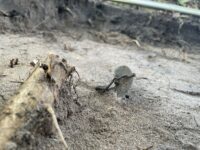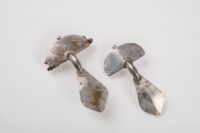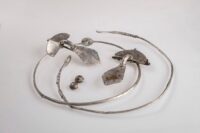 A Gothic cemetery has been unearthed in the Wda Landscape Park in northern Poland. Fifty cremation burials have been excavated so far, and they’ve barely scratched the surface of this large cemetery believed to occupy about a hectare. Grave goods of pottery, brooches, amber beads, glass beads, and everyday utilitarian objects like spindle whorls and a bone comb have been found in two types of burials: pit graves and urn burials. They date to the 4th century A.D.
A Gothic cemetery has been unearthed in the Wda Landscape Park in northern Poland. Fifty cremation burials have been excavated so far, and they’ve barely scratched the surface of this large cemetery believed to occupy about a hectare. Grave goods of pottery, brooches, amber beads, glass beads, and everyday utilitarian objects like spindle whorls and a bone comb have been found in two types of burials: pit graves and urn burials. They date to the 4th century A.D.
 While no architectural remains have been found, the park was home to an Iron Age settlement of a Wielbark-adjacent Gothic culture. They had access to local metals and the metallurgical know-how to make use of them. They extracted metals from glacial erratics (boulders deposited by flowing glaciers during the Ice Age), a highly specialized skill that required locating, preparing, crushing and roasting large stones in specialized furnaces. Several rounds of cooking were necessary before the ore could be separated from the stone sediment. Interestingly, while they buried many metal objects in their graves, they did not bury any weapons.
While no architectural remains have been found, the park was home to an Iron Age settlement of a Wielbark-adjacent Gothic culture. They had access to local metals and the metallurgical know-how to make use of them. They extracted metals from glacial erratics (boulders deposited by flowing glaciers during the Ice Age), a highly specialized skill that required locating, preparing, crushing and roasting large stones in specialized furnaces. Several rounds of cooking were necessary before the ore could be separated from the stone sediment. Interestingly, while they buried many metal objects in their graves, they did not bury any weapons.

 Archaeologist Olaf Popkiewicz made the first discovery while walking on the banks of the Wda River. He spotted silver artifacts and called in a team to excavate the find site. They unearthed a set of two silver necklaces, two silver fibulae and pieces of a silver bead necklace, all in outstanding condition. The high quality of the silver and the style of the fibulae are characteristic of the Chernyakhov culture, a Gothic people who migrated from Pomerania to the Black Sea, settling in what is now Ukraine. The fibulae date to the 5th century A.D. The necklaces were also imported. They were made in Scandinavia in the 4th century A.D. The group of silver objects therefore include pieces that range from Scandinavia in the north to the Black Sea in the southeast.
Archaeologist Olaf Popkiewicz made the first discovery while walking on the banks of the Wda River. He spotted silver artifacts and called in a team to excavate the find site. They unearthed a set of two silver necklaces, two silver fibulae and pieces of a silver bead necklace, all in outstanding condition. The high quality of the silver and the style of the fibulae are characteristic of the Chernyakhov culture, a Gothic people who migrated from Pomerania to the Black Sea, settling in what is now Ukraine. The fibulae date to the 5th century A.D. The necklaces were also imported. They were made in Scandinavia in the 4th century A.D. The group of silver objects therefore include pieces that range from Scandinavia in the north to the Black Sea in the southeast.
The condition of the open necropolis is rapidly deteriorating. Archaeologists will continue to excavate the site to salvage any remains and artifacts they can.
“They extracted metals from glacial erratics (boulders deposited by flowing glaciers during the Ice Age), a highly specialized skill that required locating, preparing, crushing and roasting large stones in specialized furnaces. Several rounds of cooking were necessary before the ore could be separated from the stone sediment. ”
That is a new bit of information for me. I had never heard of the practice. I’ll look at our local glacial erratic fieldstone more carefully from now on.